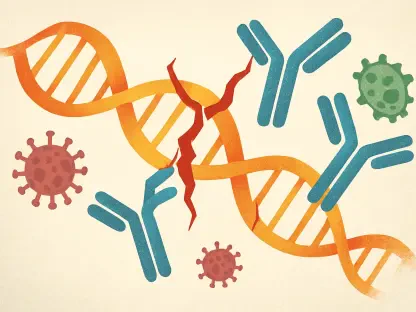What happens when a tumor outsmarts the very treatments designed to destroy it, turning a lifeline into a losing battle for countless patients? In the relentless fight against breast and ovarian cancers tied to BRCA2 deficiencies, a staggering reality emerges: chemotherapy often fails as tumors adapt and resist, leaving survival rates dishearteningly low. This feature delves into a groundbreaking discovery that peels back the layers of this deadly resistance, revealing a molecular twist that could redefine cancer treatment and ignite hope for those facing seemingly unbeatable odds.
The Weight of Resistance: Why This Matters
The significance of tackling chemoresistance in BRCA2-deficient tumors cannot be overstated. These cancers, often linked to genetic mutations, account for a substantial portion of breast and ovarian cancer cases, impacting thousands of lives annually. While initial treatments like platinum-based drugs show promise by exploiting the tumors’ inability to repair DNA damage, the recurring development of resistance transforms a potential cure into a temporary setback. Unraveling the mechanisms behind this defiance is critical, as it holds the key to extending survival and improving quality of life for patients with limited options.
A Molecular Puzzle Unraveled: The Role of BRCA2
At the heart of this challenge lies BRCA2, a protein essential for DNA repair through a process known as homologous recombination. When BRCA2 is mutated or absent, cancer cells struggle to fix double-strand DNA breaks, making them initially vulnerable to chemotherapy. However, a frustrating pattern emerges as these tumors adapt over time, finding ways to survive despite aggressive treatment. Research spearheaded by Arnab Ray Chaudhuri at Erasmus MC Cancer Institute has begun to decode this adaptability, exposing a complex interplay of proteins that allows resistant tumors to thrive against all odds.
Shocking Revelations: FIGNL1’s Sabotage
The study’s most startling finding centers on a protein called FIGNL1, previously considered a minor player in DNA repair. Contrary to decades of scientific belief that BRCA2 was the sole loader of RAD51—a crucial repair protein—onto damaged DNA, FIGNL1 actively removes RAD51 in BRCA2-deficient cells, halting repair efforts. This unexpected sabotage enables tumors to evade chemotherapy’s destructive force, as the inability to repair DNA becomes a temporary rather than permanent weakness. Such a discovery has turned long-held assumptions upside down, reshaping the understanding of cellular defense mechanisms.
Backup Plans of Cancer: The MMS22L-TONSL Lifeline
Adding another layer of complexity, the research uncovered a backup system in BRCA2-deficient tumors. When both BRCA2 and FIGNL1 are out of the equation, the MMS22L-TONSL complex steps in to ensure enough RAD51 remains on DNA for repair to occur. This alternative pathway acts as a lifeline for cancer cells, allowing them to withstand the onslaught of chemotherapy. The adaptability of these tumors, exploiting such a secondary mechanism, underscores why standard treatments often lose effectiveness over time, leaving clinicians scrambling for solutions.
Voices from the Frontline: Researchers React
The team behind this breakthrough expressed profound astonishment at their findings. Arnab Ray Chaudhuri noted, “For over two decades, the field assumed BRCA2 was indispensable for RAD51 loading, but FIGNL1’s inhibitory role caught us completely off guard.” This multinational effort, spanning institutions across the Netherlands, Switzerland, the USA, and India, highlights the global commitment to solving oncology’s toughest challenges. Their candid reflections reveal not only the surprise of the discovery but also the urgency to translate these insights into tangible benefits for patients battling resistant cancers.
Charting a New Path: Strategies to Defeat Resistance
Armed with this knowledge, the focus shifts toward actionable solutions to counter chemoresistance. Targeting the MMS22L-TONSL complex emerges as a promising strategy, potentially dismantling the backup repair pathway that sustains resistant tumors. Additionally, developing therapies that inhibit this complex must be balanced with caution to avoid harming DNA repair in healthy cells, which could lead to severe toxicity. Personalized treatment plans, tailored to patients’ molecular profiles, also offer a way forward, ensuring therapies are both effective and specific to individual cancer dynamics.
Looking back, the journey to uncover the mechanisms of chemoresistance in BRCA2-deficient tumors marked a pivotal moment in cancer research. The revelations about FIGNL1 and MMS22L-TONSL provided a foundation for future innovations. Moving forward, the scientific community must prioritize developing targeted inhibitors for these pathways, while clinical trials over the next few years, starting from 2025, will be crucial in testing their efficacy. Collaboration between researchers, clinicians, and pharmaceutical experts remains essential to transform these molecular insights into life-saving treatments, offering renewed hope to patients facing the daunting shadow of resistant cancers.









